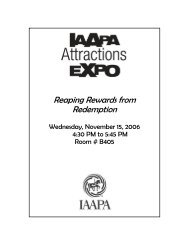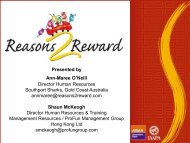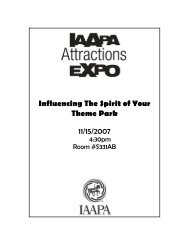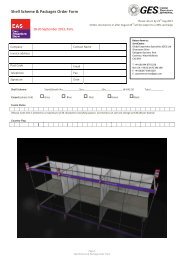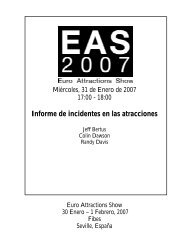Family Entertainment Centers - IAAPA
Family Entertainment Centers - IAAPA
Family Entertainment Centers - IAAPA
You also want an ePaper? Increase the reach of your titles
YUMPU automatically turns print PDFs into web optimized ePapers that Google loves.
Don Cullen follows a similar strategy. The<br />
owner of Big Don’s Wild River Mini Golf in Cicero,<br />
New York, usually won’t run more than two<br />
people at a time even though he has a 25-foot, fiveclimber<br />
wall.<br />
Cullen also adds another layer of security to his<br />
wall by fencing in the area around it. That keeps<br />
other customers from wandering underneath the<br />
climbers.<br />
Weighty Issues and Staff Training<br />
Staff members at Big Don’s rarely have to deal with<br />
plus-size guests at the wall (240 pounds is the limit<br />
for them), but they must contend with those on the<br />
smaller side.<br />
Kids need to weigh at least 45 pounds. “If they’re<br />
too light they wouldn’t have enough weight to pull<br />
the hydraulic spring-loaded system down,” Cullen<br />
says. “They could get stuck on the wall so to speak.”<br />
Young guests also may get stuck for another reason:<br />
fear of heights. It’s not uncommon for kids to<br />
get halfway up the wall, look down, and then<br />
freeze, says Rocky McIlwain, owner of Fun Zone<br />
Skate Center in Dothan, Alabama.<br />
When that happens, employees calm their skittish<br />
customers, explaining that if they let go, they’ll<br />
be OK.<br />
At ClubFX, staffers also play an active role with<br />
guests, looking for any potential problems. For<br />
example, just because a child meets the weight<br />
requirement (40 pounds), that doesn’t guarantee a<br />
ride up the wall, Connor says. He may be too young<br />
and lack the “situational awareness” to climb.<br />
In those cases, Connor might harness the child<br />
and lift him just a few feet off the ground, letting<br />
him swing around for a little bit.<br />
“They feel like a big kid,” he says. “That’s all<br />
they usually want anyway.”<br />
For the real big kids—those over 200 pounds but<br />
not at the max—Connor suggests a test run. The<br />
rate of descent increases the heavier the person, so<br />
he has them go up seven or eight feet and then<br />
drop. This way, they’ll know what to expect if they<br />
do it for real.<br />
Just in case guests (of any size) fall awkwardly,<br />
there is a four-inch thick gymnastics-type mat to<br />
catch them.<br />
The above situations show why staff preparedness<br />
plays a crucial role with rock wall safety.<br />
Cullen requires new employees to watch a training<br />
DVD, and then they’re shown up close how to<br />
operate the wall. Management observes the first<br />
20 to 30 times they hook up guests and send them<br />
skyward.<br />
An Alternative<br />
Ted Jensen, of Southampton Sports Zone,<br />
Southampton, Pennsylvania, says he doesn’t have<br />
to worry about the typical safety problems with<br />
standard rock walls. Guests on his attraction could<br />
climb 40 to 50 feet but never really get more than<br />
a few feet off the ground.<br />
Jensen’s mechanical wall is a continuous conveyer<br />
belt that goes in a circular pattern; the rocks<br />
are screwed into the stainless steel panels.<br />
A computer controls the level of difficulty, and<br />
guests have 15 different “mountains” to choose<br />
from. A monitor shows how high they’ve climbed.<br />
Customers don’t wear a harness, but the wall has<br />
built-in safety features. Sensors at the top and bottom<br />
shut down the attraction should customers try<br />
to climb over the top or fall off into the foam<br />
padding below.<br />
He bought this wall five years ago because his<br />
ceiling only stands 16 feet tall, limiting his options.<br />
The wall’s footprint is 144 square feet.<br />
“It’s a phenomenal attraction for the amount of<br />
space it takes up,” Jensen says. FW<br />
Mike Bederka is a monthly FUNWORLD contributor. He<br />
can be reached at mbederka@iaapa.org.<br />
FEC • SAFETY<br />
Five Tips to Make Your<br />
Rock Wall Successful<br />
Be sure you have the volume of people to make the<br />
1. wall a sound investment. “A much smaller segment of<br />
the population is going to be more interested than you<br />
think,” says Don Cullen of Big Don’s. For him, young kids<br />
(ages 5 to 13) climb the wall most frequently. Adults and<br />
older teens would rather go elsewhere.<br />
Keep the attraction as visible as possible, says Rocky<br />
2. McIlwain of Fun Zone. Don’t tuck it away in the back<br />
of your FEC.<br />
Always include rock climbing in any birthday party<br />
3. package, says Ken Connor of ClubFX.<br />
Make the wall relatively inexpensive. For two<br />
4. attempts, Cullen charges $4 if it’s the first activity of<br />
the day, $3 if it’s the second. Guests pay $2 a climb at Ted<br />
Jensen’s facility, Southampton Sports Zone.<br />
5. Consider a mobile wall to help expand your audience.<br />
McIlwain plans to bring his second wall to area<br />
schools for fundraisers at no charge. “It puts you in good<br />
standing in the community,” he says. In return, he hopes<br />
the administration will allow his FEC to post flyers around<br />
the school to promote special events.<br />
—Mike Bederka<br />
F E C E d i t i o n n F U NW O R L D C O L L E C T I O N S 7




